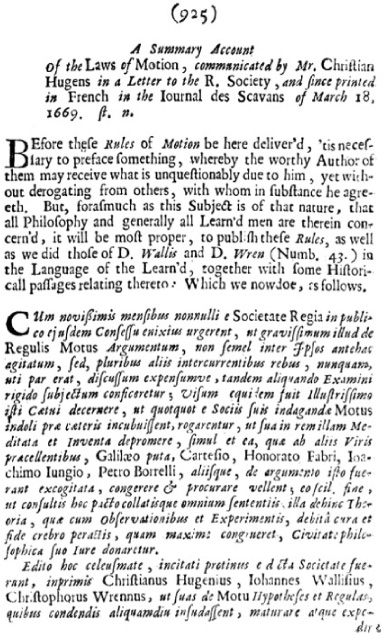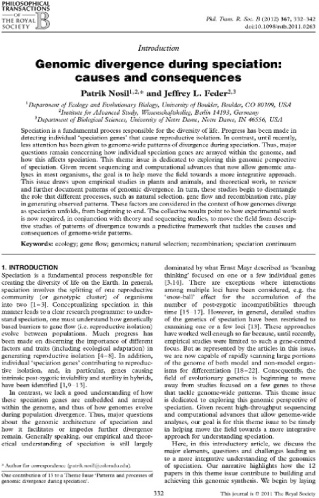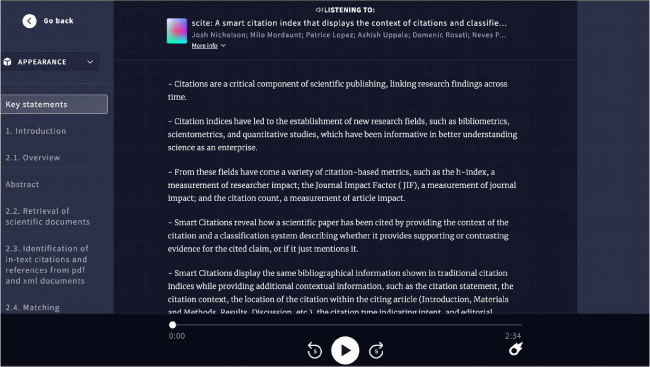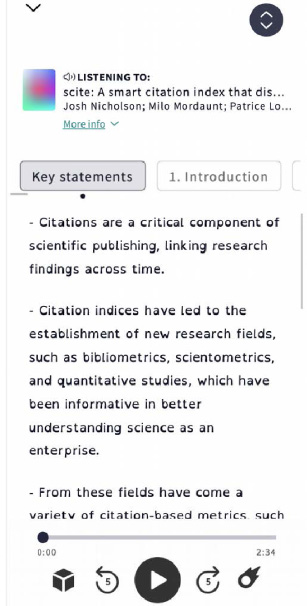Unlocking hidden knowledge: Harnessing AI, technology, and design for accessible research
Abstract
This paper is based upon a presentation at the APE conference 2023, during the ‘STM’s New Dotcoms to Watch session’ by CPO and Co-Founder Alejandro Garcia Garcia. It discussed the limitations of the existing format of published journal articles and the barriers it creates. It discusses how this can be tackled using a combination of AI, design innovation and software to create viable alternatives, and extend the reach of the content to readers outside of Academia.
1.Introduction
Research content currently requires a level of specialization to comprehend and is not accessible to the general public because of its format and its language. It can be estimated that journal articles are read on average less than 10 times [1]. This paper discusses how we can unlock this hidden knowledge, not only for academics and researchers, but for wider public benefit by using Artificial Intelligence (AI), technology and design to tackle language barriers and format accessibility.
2.Existing formats
The ‘Philosophical Transactions of the Royal Society’ is the world’s first and longest running scientific journal. However, in 350 years of its existence, there has been very little change or consideration as to the format in which research content is presented (Fig. 1 & Fig. 2).
Fig. 1.
Philosophical Transactions of the Royal Society (1669).

Fig. 2.
Philosophical Transactions of the Royal Society (2012).

Fig. 3.
Audemic scholar - desktop view (2023).

This format particularly excludes the 20% of people in the United States who have dyslexia [2] (Yale Center for Dyslexia and Creativity), other Neuro-diversities such as the 3–4% of UK adults with ADHD [3] (National Institute for Healthcare and Excellence), or the quarter of the world’s population with a diagnosed visual impairment [4] (World Health Organisation). Furthermore, reading such complex information may be inaccessible to many people due to time constraints.
Fig. 4.
Audemic scholar - mobile view (2023).

3.Existing language
Journal articles are currently written at an advanced language level. This assumes prior knowledge and an understanding of the specific technical/field vocabulary needed to set the article in context. Despite this, the average reading age of people in the UK is estimated to be that of a 9 year old [5]. It may be argued that making research content understandable to the general public is unnecessary, since most research will only be read by those studying in the field. At Audemic we believe that the opposite is true - the reason research content is not widely read by the general public, is because the language cannot be understood by many people outside of the research field.
In a time, rife with mass public mis-information, and illegitimate sources of information, it may be of public benefit to make topics like the effectiveness of face coverings in minimizing pandemic spread, success rates and risks of home births, or whether small amounts of alcohol do in fact affect sleep quality accessible. Furthermore, not only understanding the conclusion, but understanding how the conclusion was formed as credible in the eyes of an author would be incredibly useful to society as a defense against mis-information.
Naturally, today’s complex ideas may become common knowledge by 2050 and beyond. Just consider that everything taught at 5th Grade science today, has its roots in a journal article of the past. We believe that technology and AI can bring speed to this process.
4.Audemic
This paper is written from the perspective of Audemic, an organization which aims to increase the accessibility and wider impact of scholarly research, through its two software tools: Audemic insights, and Audemic Scholar [6] (Fig. 3 & Fig. 4).
Audemic Insights is an application primarily focused on those outside of Academia, gathering knowledge from the world’s scholarly articles and agency reports (Such as the World Bank etc). The application recommends relevant reading based on users interests and provides unique summaries and insights that help users to understand the information and apply the knowledge in their personal and professional day-to-day life.
Audemic Scholar is a web application that provides customizable e-reading software for students, academics and researchers that allows them to listen to (and easily understand) academic literature, making both the content easier to understand and users’ knowledge easier to organise. The application has a particular focus on accessibility and neurodiversity.
5.AI, technology and design as a tool to increase engagement
Audemic aims to provide an alternative to the existing language and PDF format used for journal articles and research content. With the Audemic Scholar web application, a customizable interface is provided, which allows users to change the way in which they can read a journal article through alternative colour overlay and font changes. It also allows users to listen to the paper via audio.
Similarly, Audemic Insights leverages large language models to provide alternative summaries to its users, with the aim of engaging the general public outside of academia with the material. One example of this in action, is taking the existing body of text from a journal article and turning it into an informal Q&A format while adding text to speech voices - Making the article alive as a conversation between fictional scientists.
6.Conclusion
It is our aim that through both Audemic applications, we can unlock a yet to be uncovered knowledge pool of research content, written by our best and brightest researchers. In the process we can ensure that future researchers have a desired impact of their work by extending their audience, to those interested in research topics but who lack the necessary formal education or time to engage with their research findings.
References
[1] | Migration (2015). Prof, no one is reading you | The Straits Times. [online] www.straitstimes.com. Available from: https://www.straitstimes.com/opinion/prof-no-one-is-reading-you#:∼:text=An%20average%20academic%20journal%20article. |
[2] | Yale Dyslexia. (2017). Dyslexia FAQ. [online] Available from: https://dyslexia.yale.edu/dyslexia/dyslexia-faq/. |
[3] | NICE (2018). Attention deficit h Attention deficit hyper yperactivity disorder: activity disorder: diagnosis and management diagnosis and management NICE guideline. [online] Available from: https://www.nice.org.uk/guidance/ng87/resources/attention-deficit-hyperactivity-disorder-diagnosis-and-management-pdf-1837699732933. |
[4] | World Health Organization (2022). Blindness and Vision Impairment. [online] Who.int. Available from: https://www.who.int/news-room/fact-sheets/detail/blindness-and-visual-impairment. |
[5] | Readable. (2020). What is the average person’s reading level? [online] Available from: https://readable.com/blog/what-is-the-average-persons-reading-level/#:∼:text=The%20average%20reader%20can%20fully [Accessed 20 Jun. 2023]. |
[6] | Audemic: Access any academic research via audio. (n.d.). audemic.io | Access any research via audio. [online] Available from: https://audemic.io/ [Accessed 20 Jun. 2023]. |



